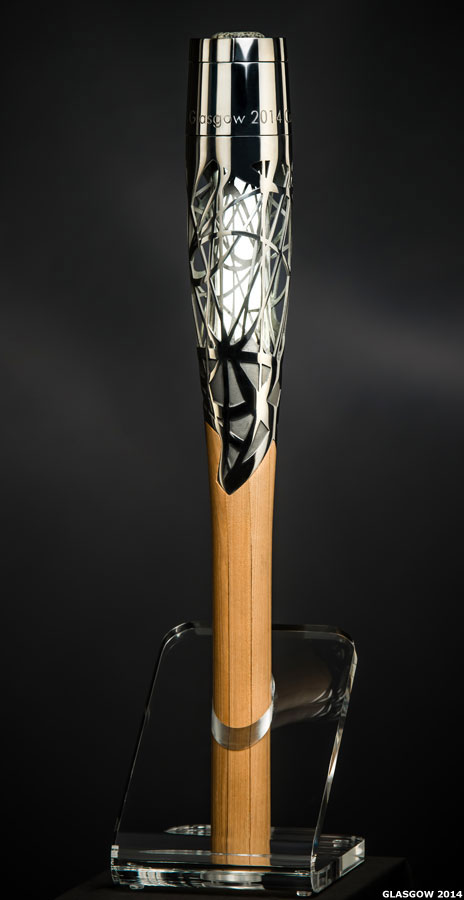Glasgow 2014: Queen's Baton Relay's Scottish dates unveiled as journey begins
- Published

Scottish athletes Russell Weir, Marc Austin, Ross Murdoch and Beverly Campbell clutch the baton in Stirling before it journeys to India
Details of the Queen's Baton Relay's route around Scotland have been unveiled as it sets off on the international leg of the journey.
The baton will visit all 70 nations and territories of the Commonwealth before the Glasgow 2014 games start at Celtic Park on 23 July.
Its 40-day tour of Scotland will begin in Edinburgh on 14 June, before ending with four days in Glasgow.
The baton left Glasgow Airport on Thursday afternoon, bound for India.
Organisers have also launched the campaign to recruit 4,000 baton-bearers.
They are seeking nominations before 22 November via the Glasgow 2014 website., external
About 100 people each day will carry the baton on its journey around the country, an event Lord Smith of Kelvin, Glasgow 2014 chairman, hopes will help in "sharing the excitement of the countdown to the Commonwealth Games with communities across the nation".
He said: "It's important as many people as possible feel part of this special moment and from today there's a chance for everyone to nominate the people in their street, village, town or city that they would like to see honoured as baton-bearers."
Commonwealth Games Minister Shona Robison said the call for nominees for baton-bearers "gives everyone in Scotland a chance to recognise up to 4,000 individuals who have made an exceptional contribution to their local community, in particular through sport or their work with young people".
On Wednesday, The Queen placed her message to the Commonwealth inside the baton during a special ceremony at Buckingham Palace.
Cyclist Sir Chris Hoy, a six-time Olympic gold and double Commonwealth gold medallist, escorted the empty baton up The Mall to the palace in London.
The Queen placed the hand-written scroll inside the specially-designed baton, which was then sealed for its 288-day journey through the Commonwealth nations and territories.
The first baton bearer was Allan Wells, the Scottish sprinter who won gold at the 1980 Moscow Olympic Games as well the Commonwealth Games in 1978 and 1982.
Stirling and Glasgow hosted official events on Thursday before the baton was transported to Glasgow Airport on its way to India.
From there, it will travel to Commonwealth nations as diverse as Bangladesh, New Zealand, Nigeria and Barbados.
However, it will not stopover in The Gambia, which last week withdrew from the Commonwealth, saying it will "never be a member of any neo-colonial institution".
The baton will return to Europe on 4 May 2014 when it will visit Cyprus, Malta and Gibraltar before going on to Jersey, Guernsey and Isle of Man, who all send their own teams to the Games.
The baton's visit to Northern Ireland begins on 20 May, Wales on 24 May and England, where it spends two weeks, from 31 May.
Glasgow 2014 will be the 20th Commonwealth Games and will feature 17 sports in 11 days of competition, with 261 medal events.
The Commonwealth of Nations has 54 members, but 70 teams participate in the Commonwealth Games because a number of British overseas territories, Crown dependencies and island states compete under their own flag.
At the top of the baton is a granite ‘gemstone’, which will be given to each nation and territory. The stones come from Ailsa Craig in the Firth of Clyde and have been crafted by Kays of Scotland and jewellers from Glasgow School of Art.
The gemstone can only be removed by opening a clever puzzle mechanism.
The lattice frame is inspired by Glasgow's industrial and architectural heritage. A process called direct metal laser sintering was used to create its organic shape by fusing together layers of pure titanium powder.
Inside the baton is a message from the Queen, written on parchment handmade in Glasgow from linen and plant fibre. Sealed with the royal seal, the message forms the 'visual core' of the baton, illuminated from within by LED lights.
The elm handle is crafted from wood from the grounds of Garrison House on the Isle of Cumbrae, and represents Scotland's natural resources. It was constructed using a boatbuilding technique known as "bird-mouthing", traditionally used to make ships' masts.
- Published11 March 2013
